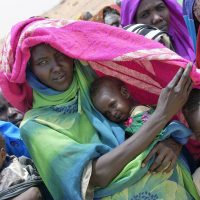Eradicating extreme poverty for all people everywhere by 2030 is a pivotal aim of the Sustainable Development Goals. Extreme poverty, defined as surviving on less than US$3.00 per person per day at 2021 purchasing power parity, has witnessed remarkable declines over recent decades.
However, in 2025, 808 million people – or 1 in 10 people worldwide – were living in extreme poverty, an upward revision from earlier estimates because of the updated poverty line. If current trends continue, 8.9 per cent of the world’s population will still live in extreme poverty by 2030.
A shocking revelation is the resurgence of hunger levels to those last observed in 2005. Equally concerning is the persistent increase in food prices across a larger number of countries compared to the period from 2015 to 2019. This dual challenge of poverty and food security poses a critical global concern.
Why is there so much poverty
Poverty has many dimensions, but its causes include unemployment, social exclusion, and high vulnerability of certain populations to disasters, diseases and other phenomena which prevent them from being productive.
Why should I care about other people’s economic situation?
There are many reasons, but in short, because as human beings, our well- being is linked to each other. Growing inequality is detrimental to economic growth and undermines social cohesion, increasing political and social tensions and, in some circumstances, driving instability and conflicts.
Why is social protection so important?
Strong social protection systems are essential for mitigating the effects and preventing many people from falling into poverty. The COVID-19 pandemic had both immediate and long-term economic consequences for people across the globe – and despite the expansion of social protection during the COVID-19 crisis, 47.6 per cent of the world’s population – about 3.8 billion people – are entirely unprotected, including 1.4 billion children in 2023.
In response to the cost-of-living crisis, 105 countries and territories announced almost 350 social protection measures between February 2022 and February 2023. Yet 80 per cent of these were short-term in nature, and to achieve the Goals, countries will need to implement nationally appropriate universal and sustainable social protection systems for all.
What can I do about it?
Your active engagement in policymaking can make a difference in addressing poverty. It ensures that your rights are promoted and that your voice is heard, that inter-generational knowledge is shared, and that innovation and critical thinking are encouraged at all ages to support transformational change in people’s lives and communities.
Governments can help create an enabling environment to generate pro- productive employment and job opportunities for the poor and the marginalized.
The private sector has a major role to play in determining whether the growth it creates is inclusive and contributes to poverty reduction. It can promote economic opportunities for the poor.
The contribution of science to end poverty has been significant. For example, it has enabled access to safe drinking water, reduced deaths caused by water-borne diseases, and improved hygiene to reduce health risks related to unsafe drinking water and lack of sanitation.

- The updated international poverty line of $3.00 resulted in a revision in the number of people living in extreme poverty from 713 to 838 million in 2022. (World Bank)
- If current trends continue, 8.9 per cent of the world’s population may still be living in extreme poverty by 2030 and only one in five countries will have halved their national poverty levels.
- For the first time on record, over half of the world’s population now receives at least one form of social protection benefit. Despite this milestone, 3.8 billion people remain uncovered.
- The share of government spending on essential services, such as education, health and social protection, is significantly higher in advanced economies than in emerging and developing economies.
- Guaranteeing basic social security floors in low- and middle-income countries requires an additional $1.4 trillion annually, or 3.3 per cent of their aggregate GDP in 2024.
- A surge in action and investment to enhance economic opportunities, improve education and extend social protection to all, particularly the most excluded, is crucial to delivering on the central commitment to end poverty and leave no one behind.
1.1 By 2030, eradicate extreme poverty for all people everywhere, currently measured as people living on less than $2.15 a day
1.2 By 2030, reduce at least by half the proportion of men, women and children of all ages living in poverty in all its dimensions according to national definitions
1.3 Implement nationally appropriate social protection systems and measures for all, including floors, and by 2030 achieve substantial coverage of the poor and the vulnerable
1.4 By 2030, ensure that all men and women, in particular the poor and the vulnerable, have equal rights to economic resources, as well as access to basic services, ownership and control over land and other forms of property, inheritance, natural resources, appropriate new technology and financial services, including microfinance
1.5 By 2030, build the resilience of the poor and those in vulnerable situations and reduce their exposure and vulnerability to climate-related extreme events and other economic, social and environmental shocks and disasters
1.A Ensure significant mobilization of resources from a variety of sources, including through enhanced development cooperation, in order to provide adequate and predictable means for developing countries, in particular least developed countries, to implement programmes and policies to end poverty in all its dimensions
1.B Create sound policy frameworks at the national, regional and international levels, based on pro-poor and gender-sensitive development strategies, to support accelerated investment in poverty eradication actions
Related News
Young people take the lead for a more sustainable future
More than half the world’s population is under 30, and young people are leading grassroots efforts on issues from climate action to equality. Marking International Youth Day on Tuesday, the UN is highlighting the power of youth to transform their communities – and the wider world.
Preparing for the next flood: Protecting women’s health in Bangladesh
Climate change has worsened monsoon flooding in Bangladesh, putting women of child-bearing age at risk – but the UN reproductive health agency (UNFPA) is helping them prepare. Read Full Story on UN News
Closing Press Release | Third UN Conference on Landlocked Developing Countries (LLDC3)
Media Advisory | UN Forum to boost momentum towards 2030 | Opening day features launch of the latest SDG data
Related Videos
Deputy UN chief urges bold action to transform food systems at global summit in Addis Ababa
United Nations Deputy Secretary-General Amina Mohammed on Tuesday called on countries to double down on efforts to transform food systems, describing them as “one of the greatest solutions” to achieving the Sustainable Development Goals (SDGs).
Once-in-a-decade push for the ‘locked out’: Global leaders set for landmark UN conference in Turkmenistan
In early August, Heads of State, ministers, investors and grassroots leaders will gather in Awaza on Turkmenistan’s Caspian coast for once-in-a-decade UN conference aiming to rewire the global system in support of 32 landlocked developing countries whose economies are often “locked out” of opportunity due to their lack of access to the sea.
In Myanmar, conflict and floods collide as UN warns of deepening crisis
As Myanmar reels from deadly floods, renewed fighting and widespread displacement, the United Nations warned on Thursday that urgent humanitarian needs are going unmet due to escalating violence and blocked access. Read Full Story on [...]
Trade measures critical to ending plastic pollution
Trade must be part of the solution to end plastic pollution – a global problem which disproportionately affects developing countries. Read Full Story on UN News









